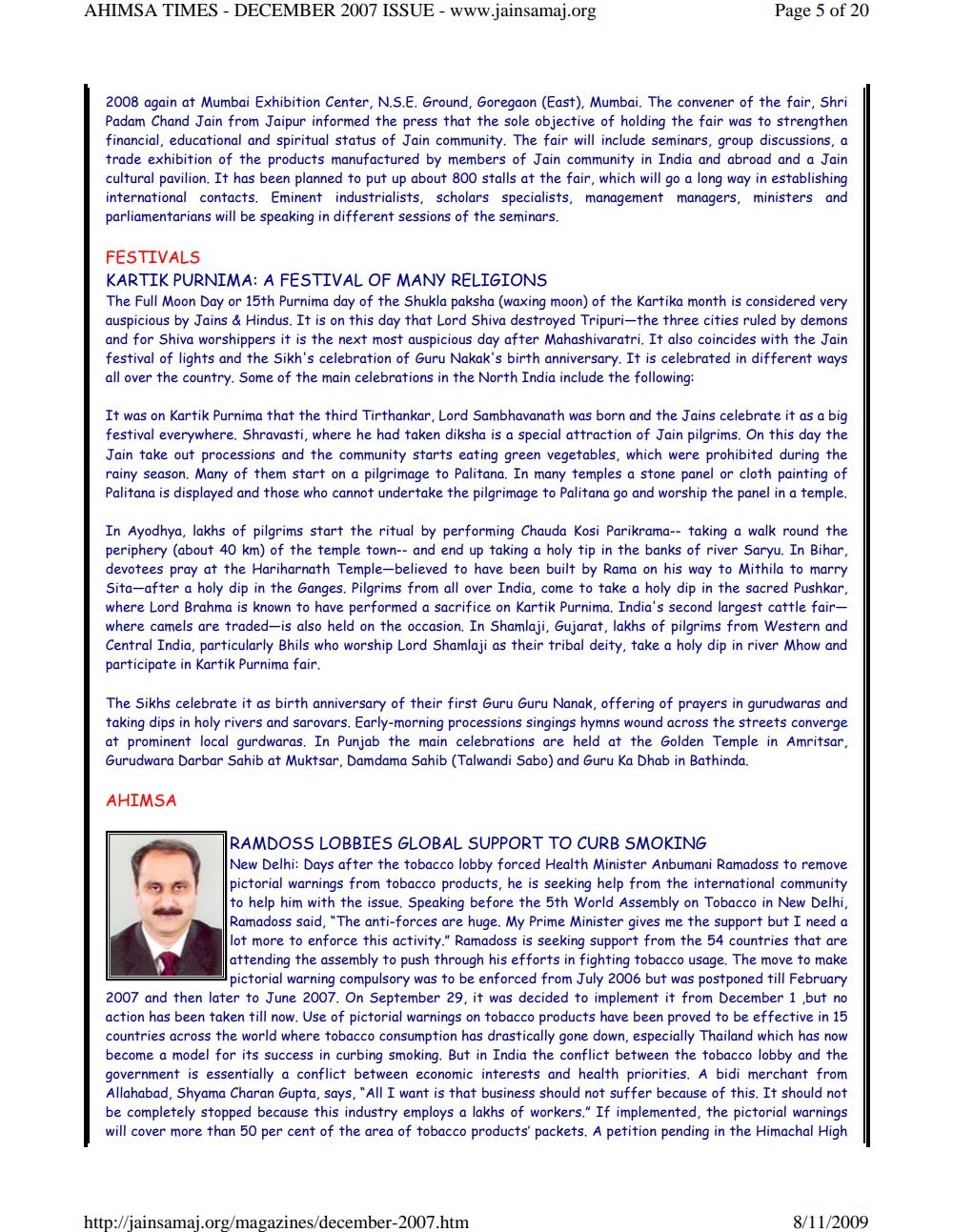Book Title: Ahimsa Times 2007 12 SrNo 90 Author(s): Ahimsa Times Publisher: Ahimsa Times View full book textPage 5
________________ AHIMSA TIMES - DECEMBER 2007 ISSUE - www.jainsamaj.org Page 5 of 20 2008 again at Mumbai Exhibition Center, N.S.E. Ground, Goregaon (East), Mumbai. The convener of the fair, Shri Padam Chand Jain from Jaipur informed the press that the sole objective of holding the fair was to strengthen financial, educational and spiritual status of Jain community. The fair will include seminars, group discussions, a trade exhibition of the products manufactured by members of Jain community in India and abroad and a Jain cultural pavilion. It has been planned to put up about 800 stalls at the fair, which will go a long way in establishing international contacts. Eminent industrialists, scholars specialists, management managers, ministers and parliamentarians will be speaking in different sessions of the seminars, FESTIVALS KARTIK PURNIMA: A FESTIVAL OF MANY RELIGIONS The Full Moon Day or 15th Purnima day of the Shukla paksha (waxing moon) of the Kartika month is considered very auspicious by Jains & Hindus. It is on this day that Lord Shiva destroyed Tripuri-the three cities ruled by demons and for Shiva worshippers it is the next most auspicious day after Mahashivaratri. It also coincides with the Jain festival of lights and the Sikh's celebration of Guru Nakak's birth anniversary. It is celebrated in different ways all over the country. Some of the main celebrations in the North India include the following: It was on Kartik Purnima that the third Tirthankar, Lord Sambhavanath was born and the Jains celebrate it as a big festival everywhere. Shravasti, where he had taken diksha is a special attraction of Jain pilgrims. On this day the Jain take out processions and the community starts eating green vegetables, which were prohibited during the rainy season. Many of them start on a pilgrimage to Palitana. In many temples a stone panel or cloth painting of Palitana is displayed and those who cannot undertake the pilgrimage to Palitana go and worship the panel in a temple. In Ayodhya, lakhs of pilgrims start the ritual by performing Chauda Kosi Parikrama-- taking a walk round the periphery (about 40 km) of the temple town-- and end up taking a holy tip in the banks of river Saryu. In Bihar, devotees pray at the Hariharnath Temple-believed to have been built by Rama on his way to Mithila to marry Sita-after a holy dip in the Ganges. Pilgrims from all over India, come to take a holy dip in the sacred Pushkar, where Lord Brahma is known to have performed a sacrifice on Kartik Purnima. India's second largest cattle fairwhere camels are traded-is also held on the occasion. In Shamlaji, Gujarat, lakhs of pilgrims from Western and Central India, particularly Bhils who worship Lord Shamlaji as their tribal deity, take a holy dip in river Mhow and participate in Kartik Purnima fair. The Sikhs celebrate it as birth anniversary of their first Guru Guru Nanak, offering of prayers in gurudwaras and taking dips in holy rivers and sarovars. Early morning processions singings hymns wound across the streets converge at prominent local gurdwaras. In Punjab the main celebrations are held at the Golden Temple in Amritsar, Gurudwara Darbar Sahib at Muktsar, Damdama Sahib (Talwandi Sabo) and Guru Ka Dhab in Bathinda. AHIMSA RAMDOSS LOBBIES GLOBAL SUPPORT TO CURB SMOKING New Delhi: Days after the tobacco lobby forced Health Minister Anbumani Ramadoss to remove pictorial warnings from tobacco products, he is seeking help from the international community to help him with the issue. Speaking before the 5th World Assembly on Tobacco in New Delhi, Ramadoss said, "The anti-forces are huge. My Prime Minister gives me the support but I need a lot more to enforce this activity." Ramadoss is seeking support from the 54 countries that are attending the assembly to push through his efforts in fighting tobacco usage. The move to make pictorial warning compulsory was to be enforced from July 2006 but was postponed till February 2007 and then later to June 2007. On September 29, it was decided to implement it from December 1 ,but no action has been taken till now. Use of pictorial warnings on tobacco products have been proved to be effective in 15 countries across the world where tobacco consumption has drastically gone down, especially Thailand which has now become a model for its success in curbing smoking. But in India the conflict between the tobacco lobby and the government is essentially a conflict between economic interests and health priorities. A bidi merchant from Allahabad, Shyama Charan Gupta, says, "All I want is that business should not suffer because of this. It should not be completely stopped because this industry employs a lakhs of workers." If implemented, the pictorial warnings will cover more than 50 per cent of the area of tobacco products' packets. A petition pending in the Himachal High http://jainsamaj.org/magazines/december-2007.htm 8/11/2009Page Navigation
1 ... 3 4 5 6 7 8 9 10 11 12 13 14 15 16 17 18 19 20
